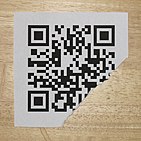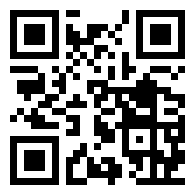This is an old revision of this page, as edited by Kuru (talk | contribs) at 11:03, 5 October 2021 (→Semi-protected edit request on 5 October 2021: reply). The present address (URL) is a permanent link to this revision, which may differ significantly from the current revision.
Revision as of 11:03, 5 October 2021 by Kuru (talk | contribs) (→Semi-protected edit request on 5 October 2021: reply)(diff) ← Previous revision | Latest revision (diff) | Newer revision → (diff)| This is the talk page for discussing improvements to the QR code article. This is not a forum for general discussion of the article's subject. |
|
| Find sources: Google (books · news · scholar · free images · WP refs) · FENS · JSTOR · TWL |
| Archives: 1Auto-archiving period: 4 months |
| This article has not yet been rated on Misplaced Pages's content assessment scale. It is of interest to the following WikiProjects: | ||||||||||||||||||||||||||||
Template:Vital article
Please add the quality rating to the {{WikiProject banner shell}} template instead of this project banner. See WP:PIQA for details.
{{WikiProject banner shell}} template instead of this project banner. See WP:PIQA for details.
{{WikiProject banner shell}} template instead of this project banner. See WP:PIQA for details.
| ||||||||||||||||||||||||||||
| Editors interested in this article may also be interested in the QRpedia project. See also the defunct Semapedia project. |
 | On 2 June 2010, QR code was linked from Slashdot, a high-traffic website. (Traffic) All prior and subsequent edits to the article are noted in its revision history. |
|
Archives |
|
This page has archives. Sections older than 120 days may be automatically archived by Lowercase sigmabot III when more than 5 sections are present. |
Editing for better readability
The page right now has a ton of redundant information, overlap and missing links. I would assume that if I am here to learn about QR Codes, I should also be introduced to all the possible use-cases, the current issues that are being solved using QR Codes (like climate change and authentication) and where I might be able to create a QR Code for myself. What's the protocol for this?
Snehratna (talk) 06:17, 24 January 2020 (UTC)
Possibly a hidden Ad Campaign?
Note that reference 50 leads to http://vitreoqr.com/2014/QR_Code.html a company that CLEARLY is selling QR Codes. We should also note that everyone CAN download the iQR generator from Denso-Wave's website after registering (free): http://www.denso-wave.com/en/adcd/product/software/building/qrdraw-ad.html IMHO, this reference should be changed or removed. I'd put this as the reference instead: http://www.qrcode.com/en/codes/iqr.html — Preceding unsigned comment added by 188.250.154.18 (talk • contribs) 16:32, 4 July 2014
Misleading risks section
QR code#Risks is misleading - as this article explains, it's the URL the 2D barcodes decode to that's malicious, giving a link to a virus in an app store. So the 2D barcode doesnt contain an executable that the reader is to execute according to the decoding protocol, & the same vulnerability applies to all 2D barcodes and data sharing media. 131.191.99.210 (talk) 13:41, 11 March 2019 (UTC)
- The claim is that the URL itself can include JavaScript that can attack the browser directly. Even if it's a simple non-executable URL, it can point to a web page that attacks your browser. In theory JavaScript and web pages are safe, but in practice browsers have bugs that can be exploited. It isn't necessary that you download an app. Jordan Brown (talk) 16:09, 23 October 2019 (UTC)
- Jordan Brown, you may be right, but Misplaced Pages policy (WP:VERIFY) is "verifiability, not truth". The above reference says "QR codes cannot be viruses. At the worst case they can point to a URL that .. if you choose to download it ... may ... download a malware." Do you have any reference that says that the URL can contain malicious JavaScript? (The "EvilQR" reference *speculates* that such a malicious URL may be possible, and I agree that practically any URL can be encoded into a QR code, but their testing seems to indicate that most of the tested QR decoders (19 out of 21) didn't execute any JavaScript embedded embedded into the URL before asking for confirmation. The "alert" of the remaining 2 QR decoders is alarming, but it's not clear that indicates a real problem. --DavidCary (talk) 03:15, 24 December 2019 (UTC)
- You could have a QR code that attacks the decoder, a QR code that encodes a URL (JavaScript or not) that attacks the browser, or a QR code that encodes a URL that points to a malicious web page. All are certainly plausible, and all have the same end result: your device is attacked. I wouldn’t consider the difference to be important to a non-technical audience. It would be a serious disservice to say that QR codes are safe, without mentioning the risks associated with the remainder of the pipeline. All that said, I’m not unhappy with the current text. It could be finessed a bit to be more technically accurate while still conveying the key warning: that there is a risk. Jordan Brown (talk) 18:44, 28 December 2019 (UTC)
- The last sentence of the section is also misleading. I have not found The Wire page linked in the references, but after searching for Russian language sources for this, I found https://xakep.ru/2011/10/03/57128/ (in Russian) and https://securelist.com/malicious-qr-codes-pushing-android-malware/31386/ (in English). Both of these pages describe an Android trojan that was spread via QR codes and sent the $6 texts. I think that while using the codes to spread malware is definitely a risk, it was not the code itself that caused the phones that scanned it to send the messages (this would be the case if they used a vulnerability in the reader app to do this). X0wl (talk) 15:39, 13 July 2020 (UTC)
Can anyone scan the first example in the error correction section?
I thought the little square on the corner was one of the essential parts that must be present for a code to be readable... --95.92.219.13 (talk) 07:42, 5 July 2019 (UTC)

- Yes, I just now used the ZXing project's Android app to read that QR code with the lower-right corner torn off, and it decoded correctly (to a link to http://en.m.wikipedia.org ).
- So apparently that little square alignment mark is *not* essential. --DavidCary (talk) 03:15, 24 December 2019 (UTC)
01703830469 — Preceding unsigned comment added by 103.107.123.220 (talk) 06:34, 7 February 2021 (UTC)
29191
i dont know why at the top of the page it says 29191. maybe it should be there maybe it shouldnt. idk so im keeping it there and posting this Bumpf (talk) 18:29, 25 February 2021 (UTC)bUMPF
Possible Error in Second Image Under #Encoding
For the second image under #Encoding (https://en.wikipedia.org/File:QR_Character_Placement.svg), I'm pretty sure the words even and odd have been switched. I tried decoding it to binary by hand, and it doesn't make any sense if I use what they have, but if I change it so "dark is 0 on odd rows, 1 on even rows" I get the expected output. However, I'm not entirely sure if my suspicions are correct, and I don't have the permissions to change the image, so I've added it to the talk page. Edit: Actually, it's possible the text in the image is correct if it's assumed that the rows start at 0 from the bottom. It would most likely be helpful to label rows on the image. SapphireDroplets (talk) 02:19, 1 March 2021 (UTC)
New image?

Can we make this the new infobox image? Please? Pretty please? Even temporarily, like on April 1? --Diriector_Doc├─────┤Contribs 22:23, 4 March 2021 (UTC)
Semi-protected edit request on 5 October 2021
This edit request has been answered. Set the |answered= or |ans= parameter to no to reactivate your request. |
91.108.136.57 (talk) 07:34, 5 October 2021 (UTC)
- Not clear what the request is. Kuru (talk) 11:03, 5 October 2021 (UTC)

